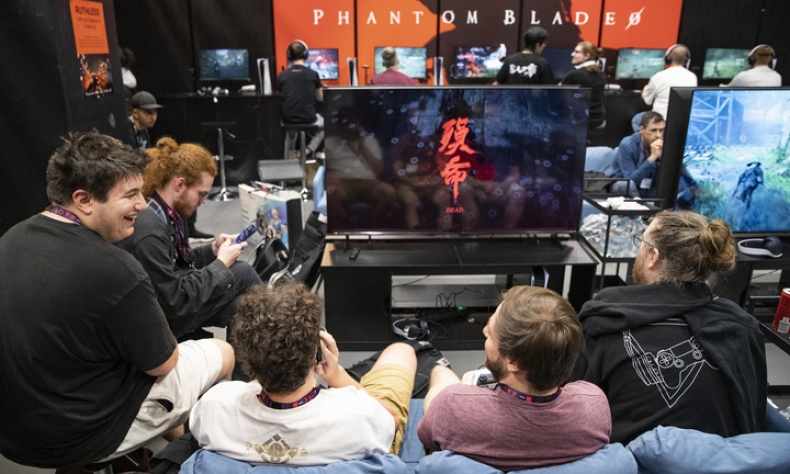China’s Cultural Surge in Digital Content

China’s digital cultural products, including video games, online literature, and dramas, have become mediums for sharing Chinese culture globally, enhancing cultural understanding and exchange.
Since its release on video game distribution services in August, Black Myth: Wukong, an action role-playing game developed and published by Chinese video game developer and publishing company Game Science, has garnered a lot of attention and excitement globally, becoming one of the most talked-about games to have come out in recent years.
In just a month, the hit game sold more than 20 million copies on globally leading digital distribution platform Steam. Chinese securities company Huatai Securities has predicted that the game could sell 30 to 40 million copies within a year.
Besides being seen as a new standard-bearer for the Chinese video game industry, the game serves as an important cultural bridge for global players to learn about China. Black Myth: Wukong draws inspiration from the classic Chinese novel Journey to the West, focusing on Sun Wukong, or the Monkey King. The game’s unique art direction reflects traditional Chinese aesthetics, showcasing landscapes, architecture and design elements that highlight China’s abundant cultural heritage. As players engage with the game, discussions around its themes, storylines and characters can promote a deeper understanding of Chinese culture and values.
In recent years, China’s digital cultural products, including video games, online literature, and dramas, have swiftly progressed with the evolution of digital technology, offering diverse content. They have become mediums for sharing Chinese culture globally, enhancing cultural understanding and exchange.
Online treats
On April 20, 1994, the Institute of High Energy Physics at the Chinese Academy of Sciences built the first Internet cable connection enabling e-mail communication between China, North America and Europe.
Six years later, the first Chinese-developed online video game, the King of Kings, was launched, cultivating the country’s first generation of online gamers and opening up China’s vast online gaming market. Soon after, with the introduction of more domestic online games and imported ones such as the Legend of Mir, released by the Republic of Korea’s provider Netblue Games, and World of Warcraft, by American video game giant Blizzard Entertainment, the online gaming market flourished, attracting the attention and participation of countless enthusiasts.
But at that time, many domestic game developers struggled to create immersive worlds and compelling storylines. After 2010, as smartphones became more widespread, manufacturers observed a shift in consumer trends from PCs to mobile platforms.
Mobile games, as one of the most profitable segments of the mobile Internet, attracted attention from traditional companies due to their immense commercial potential.
A report released by Chinese mobile application and game data service provider Diandian in July stated that the number of Chinese mobile gamers today has exceeded 800 million.
Chinese game developers have skillfully blended traditional cultural aspects such as music, poetry, ink-wash painting and martial arts, with modern game design. This fusion allows players to enjoy engaging gameplay while immersing themselves in the richness and depth of Chinese culture.
Take Black Myth: Wukong as an example. It features ancient Chinese architecture at historic locations such as the Yungang Grottoes in Datong, Shanxi Province in north China, and the Kaiyuan Temple in Quanzhou in the southeastern province of Fujian. One battle features the distant view of an ancient temple modeled after the Dule Temple in Tianjin. The temple is one of the country’s few remaining structures from the Liao Dynasty (916-1125). Since the game’s release, tourists have been flocking to these places in droves.

The game stars an assortment of demons, demon kings, gods and Buddhas, all shaped with distinct Chinese aesthetics. Together, they form a contemporary illustrated compendium inspired by The Classic of Mountains and Seas, an ancient catalog of supernatural flora and fauna that allegedly dates back some 2,000 years. The book has long been a major source of Chinese mythology, and the game draws upon it to enrich its roster of characters with mythical depth and cultural meaning.
Additionally, it features traditional Chinese instruments such as the guzheng, bowls, wooden clappers and gongs. Much of the music was composed using Chinese-style chord structures.
Like online games, Chinese web literature, too, has gathered a large fanbase after more than two decades of development.
The country’s web literature users had surpassed 500 million as of 2023, according to the blue book of China’s online literature, released by the China Writers Association (CWA) in April. The 52nd Statistical Report on China’s Internet Development, released by the China Internet Network Information Center in August 2023, revealed that the number of Chinese netizens had reached 1.079 billion, and nearly half of them were web literature users.
Over 30 million literary works had been published online by the end of last year, with about 2 million newly published in 2023 alone, the blue book said. It added that the combined revenue of the country’s 50 major online literature platforms had reached 34 billion yuan ($4.7 billion) in 2023. Data from these platforms also indicated that the amount of newly registered authors had risen by 10 percent year on year to nearly 2.5 million last year.
Many popular genres and subgenres have been invented and reinvented in astonishing variety to meet the ever-evolving reader demand. Examples include science fiction, tomb-robbing, time travel, stories based on animation, comics and games, sports, Eastern fantasies, and horror.
The CWA has reported that the flourishing of web literature has also spurred the growth of online dramas, particularly micro-dramas—a new format of online video entertainment where episodes are just a few minutes long but can exceed 100 episodes in total. Revenue from micro-dramas now constitutes a substantial share of the web literature industry. As of late 2023, over 3,000 web literature works had been adapted into micro-dramas. In the previous year alone, over 1,400 micro-dramas were released, pushing the industry’s market value to over 37 billion yuan ($5 billion), reflecting a year-on-year increase of 268 percent.
The rise of micro-dramas can be traced back to 2009, when video-streaming platforms were still in their infancy in China. At that time, traditional cable television remained the preferred choice for many Chinese households.
However, with the emergence of mobile Internet and the widespread embrace of short video platforms among smartphone users, the micro-drama market began to thrive.
Showcasing China
The appeal of Chinese digital content isn’t just limited to China’s domestic market. Globally, a burgeoning wave of Chinese dramas has unfurled. Statistics from the National Radio and Television Administration, the country’s top regulator in the sector, show that TV dramas accounted for 80 percent of all Chinese visual and audio content distributed overseas in 2023, reaching audiences in more than 200 countries and regions.
Cultural products are now opting for new pathways to go global by establishing online platforms, creating overseas bases and building their own brands. For instance, Chinese online video platforms like Tencent Video, iQIYI, Mango TV and YouTube equivalent Bilibili have launched international versions that synchronize content for overseas audiences.

Additionally, the expansion of micro-short dramas in international markets has led to the launch of numerous apps. As of late February, over 40 short drama apps had tested waters in overseas markets, with nearly 55 million downloads and combined in-app revenue reaching $170 million, according to digital economy market research agency Sensor Tower.
Zhang Yiwu, a professor of Chinese literature at Peking University, noted that simply exporting shows without adapting them can lead to mismatches, where content doesn’t resonate with foreign audiences. He emphasizes that by adapting them to local communication norms, such as localized platforms, can better meet viewer needs and create a sense of familiarity for international audiences, facilitating a smoother cultural exchange.
Online Chinese literature has been attracting worldwide fans as well. The overseas market for Chinese web literature surpassed 4 billion yuan ($651 million) in 2023, attracting nearly 200 million active users globally, the CWA said.
Chinese online literary works have been translated into more than 20 languages, covering over 40 countries and regions in Southeast Asia, North America, Europe and Africa, according to a report released by the China Audio-video and Digital Publishing Association in late 2023.
Professor Fang Ying from the School of Economics and Management at the Communication University of China, who has researched digital cultural trade for many years, stressed a core component of the global expansion of online literature: co-creation. Platforms like Qidian International have opened up creative functions for overseas users, allowing readers, authors and fans abroad to contribute to the creation of online literary works. As a result, thanks to the contributions of overseas aficionados, the cultural perspectives and values of these intellectual properties (IPs) become wholly globalized. The future development of online literature requires achieving industrial integration and building a global IP ecosystem.
Quality over quantity
Despite the rising popularity and seemingly unstoppable growth of online video games, literature and dramas, these fields are still far from perfect. For instance, the online drama market has seen an increase in imitations and plagiarized works. Additionally, some of these productions prioritize plot conflicts and suspense at the expense of character development and narrative depth.
“Explosive growth has generated some chaos; and vulgar, violent, and pornographic content has somewhat damaged the online content ecology,” Zhang Peng, a film researcher at the National Research Center of Cultural Industries of Nanjing University, noted on the development of micro-dramas in China.
In November 2022, China’s National Radio and Television Administration issued a notice on the rectification of online micro-dramas and their quality guarantee. Three months of special rectification undertakings then produced positive results. For example, as of February 28, 2023, over 25,300 micro-dramas containing pornographic, vulgar or violent content had been taken down.
Ni Ke, who worked as an overseas web literature editor for four years, told newspaper Workers’ Daily that the range of online literature currently being exported remains quite limited, with considerable issues of homogenization. The dominant genres include historical fantasy and urban romance.
“While these are visually appealing and easy to digest, overseas audiences may grow tired of them after a while,” Ni said.
Ding Hanqing, Deputy Dean of the School of Journalism and Communication at Beijing Normal University, noted that the existing problems of homogenization and limited range are likely to be corrected through market competition. “When users grow weary of similar content, creators who offer high-quality and unique works have the potential to succeed,” she added.
 Facebook
Facebook
 Twitter
Twitter
 Linkedin
Linkedin
 Google +
Google +










